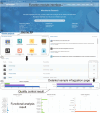MicroEXPERT: Microbiome profiling platform with cross-study metagenome-wide association analysis functionality
- PMID: 38868224
- PMCID: PMC10989818
- DOI: 10.1002/imt2.131
MicroEXPERT: Microbiome profiling platform with cross-study metagenome-wide association analysis functionality
Abstract
The framework of the MicroEXPERT platform. Our Platform was composed of five modules. Data management module: Users upload raw data and metadata to the system using a guided workflow. Data processing module: Uploaded data is processed to generate taxonomical distribution and functional composition results. Metagenome-wide association studies module (MWAS): Various methods, including biomarker analysis, PCA, co-occurrence networks, and sample classification, are employed using metadata. Data search module: Users can query nucleotide sequences to retrieve information in the MicroEXPERT database. Data visualization module: Visualization tools are used to illustrate the metagenome analysis results.
© 2023 The Authors. iMeta published by John Wiley & Sons Australia, Ltd on behalf of iMeta Science.
Conflict of interest statement
Jialiang Yang, Lei Ji, and Geng Tian are employed by Geneis Beijing Co., Ltd. Haixia Long and Kaimei Huang are employed by Sequenxe Biological Technology Co., Ltd. The remaining authors declare no conflict of interest.
Figures



Similar articles
-
FAIR compliant database development for human microbiome data samples.Front Cell Infect Microbiol. 2024 May 7;14:1384809. doi: 10.3389/fcimb.2024.1384809. eCollection 2024. Front Cell Infect Microbiol. 2024. PMID: 38774631 Free PMC article.
-
Meta-analysis of Clinical Microbiome Studies in Urolithiasis Reveal Age, Stone Composition, and Study Location as the Predominant Factors in Urolithiasis-Associated Microbiome Composition.mBio. 2021 Aug 31;12(4):e0200721. doi: 10.1128/mBio.02007-21. Epub 2021 Aug 10. mBio. 2021. PMID: 34372696 Free PMC article.
-
OMARU: a robust and multifaceted pipeline for metagenome-wide association study.NAR Genom Bioinform. 2022 Mar 7;4(1):lqac019. doi: 10.1093/nargab/lqac019. eCollection 2022 Mar. NAR Genom Bioinform. 2022. PMID: 35265838 Free PMC article.
-
Metagenome-wide association studies: fine-mining the microbiome.Nat Rev Microbiol. 2016 Aug;14(8):508-22. doi: 10.1038/nrmicro.2016.83. Epub 2016 Jul 11. Nat Rev Microbiol. 2016. PMID: 27396567 Review.
-
A practical guide to amplicon and metagenomic analysis of microbiome data.Protein Cell. 2021 May;12(5):315-330. doi: 10.1007/s13238-020-00724-8. Epub 2020 May 11. Protein Cell. 2021. PMID: 32394199 Free PMC article. Review.
Cited by
-
Phylogeny-metabolism dual-directed single-cell genomics for dissecting and mining ecosystem function by FISH-scRACS-seq.Innovation (Camb). 2025 Jan 16;6(3):100759. doi: 10.1016/j.xinn.2024.100759. eCollection 2025 Mar 3. Innovation (Camb). 2025. PMID: 40098675 Free PMC article.
References
LinkOut - more resources
Full Text Sources
